Toothpaste for Braces: The Best Options for Keeping Your Smile Clean
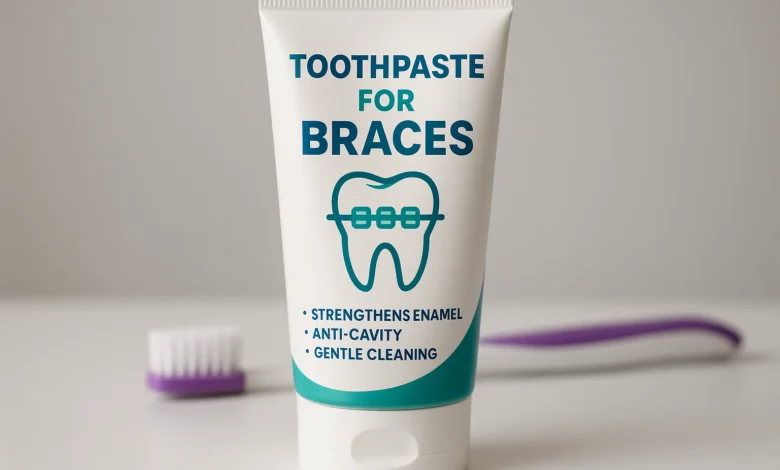
Toothpaste for Braces: A Complete Guide to Oral Care During Orthodontic Treatment
Introduction
Braces serve two purposes by correcting tooth alignment while enhancing dental wellness. The maintenance of proper oral care presents a challenge when wearing braces. The orthodontic devices including braces and wires and bands and other equipment create obstacles for proper hygiene maintenance so the correct toothpaste for braces must be used. The failure to follow proper oral hygiene procedures will lead to plaque accumulation and food particle retention and other forms of hygiene neglect.
This guide provides step-by-step instructions for orthodontic toothpaste use while explaining its essential components to help users establish an optimal braces hygiene routine. This guide contains all necessary information for braces hygiene whether you are starting orthodontic treatment or want to enhance your existing routine.
1. Why is Choosing the Right Toothpaste for Braces Important?
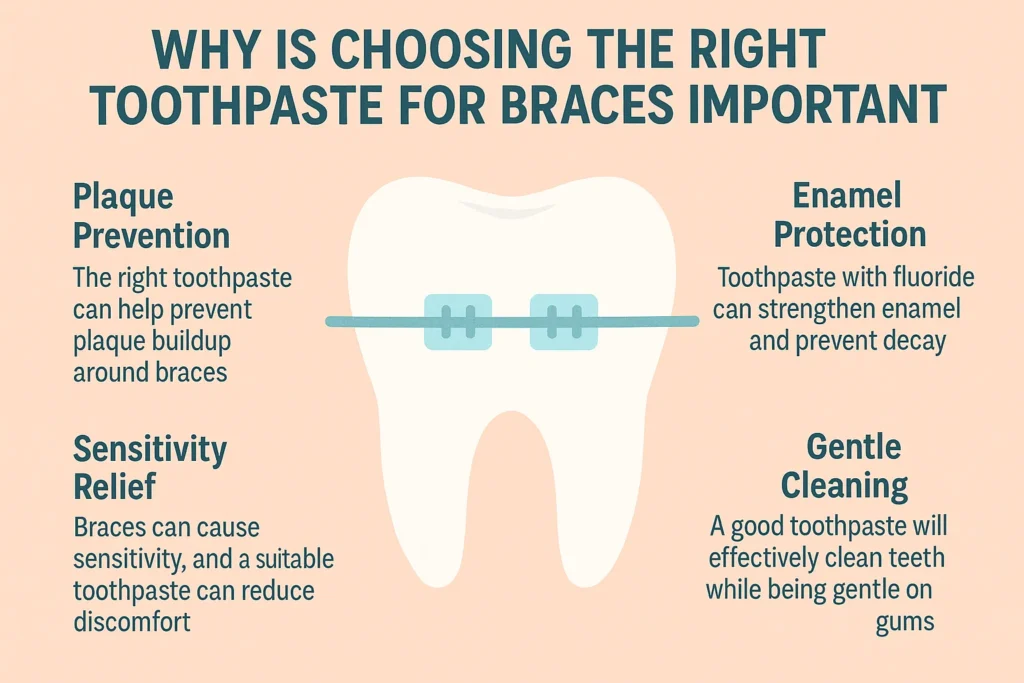
Now that you have braces, practicing oral hygiene becomes more difficult due to wires, brackets, and bands. These parts can entrap food, bacteria, and plaque that may lead to cavities, gum disease, and tooth decay if not cleaned properly.
- Due to having braces, a proactive tube of toothpaste that works really well to clean tooth brackets and wires is of great benefit because it:
- Prevention of tooth decay and weakening of the enamel due to decay and stains is mitigated due to the products protective layers.
- Mitigated due to the products protective layers, the plaque fighting action can stave off gum inflammation and other oral health issues.
- Decreased risk of staining of tooth enamel that occurs due to having braces.
Your choice of toothpaste can have a huge impact on your oral health while braces are actively straightening your teeth.
2. What Ingredients Should Toothpaste for Braces Contain?
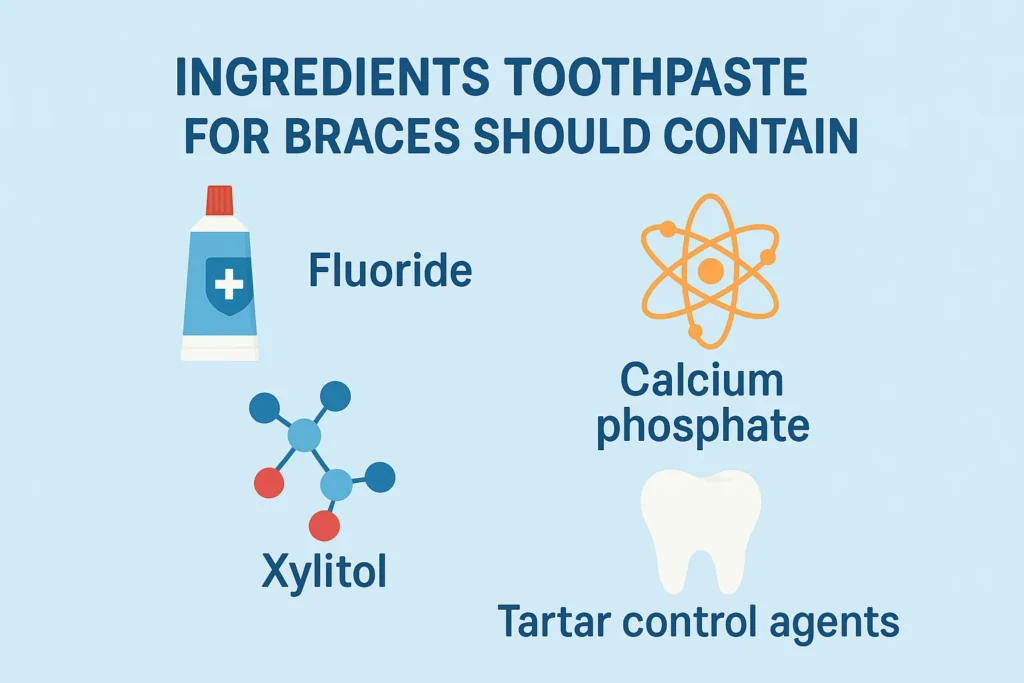
When selecting toothpaste for braces, it’s essential to choose a product with the right ingredients to support effective cleaning. Here are some key ingredients to look for:
1. Fluoride
The importance of fluoride in toothpaste becomes critical for people who wear braces. The cariostatic properties of fluoride help enamel remineralize which prevents tooth decay and cavities from forming especially when food and bacteria get trapped in and around braces.
Benefits of Fluoride:
The substance enhances enamel resistance to acid which helps stop cavity formation.
The process of enamel remineralization helps repair small enamel damages before they develop into cavities.
2. Antibacterial Agents
The antibacterial agents present in toothpaste work to decrease the formation of plaque near your brackets and wires. The agents work to control the bacteria which cause gum disease and bad breath.
Benefits of Antibacterial Agents:
- Reduces plaque and tartar buildup.
- The agents help prevent gingivitis which frequently affects people who have braces.
- Your mouth stays fresh while bad breath prevention occurs.
3. Mild Abrasives
The mild abrasive properties in toothpaste enable you to remove food particles and plaque from your teeth without harming your enamel. The abrasives in toothpaste need to be gentle because harsh abrasives can damage your enamel.
Benefits of Mild Abrasives:
- The surface stains and plaque can be effectively removed by this product.
- The product cleans around brackets and wires without damaging the enamel.
4. Xylitol
Some toothpaste brands add xylitol, a natural sweetener that helps prevent cavity-causing bacteria from sticking to the teeth. Xylitol can also help remineralize enamel and improve overall oral health.
Benefits of Xylitol:
Reduces the growth of bacteria that cause tooth decay.
Helps maintain oral hygiene by fighting plaque.
3. Best Types of Toothpaste for Braces
Choosing the right toothpaste can significantly impact your oral health while wearing braces. Here are the best types of toothpaste for braces:
Fluoride Toothpaste
Most orthodontists recommend using fluoride toothpaste for braces. Fluoride helps prevent cavities and strengthens tooth enamel, which is especially important when you have braces.
Popular Fluoride Toothpaste Options:
Colgate Total
Sensodyne Pronamel
Oral-B Pro-Expert
Whitening Toothpaste
Using whitening toothpaste with braces is not suitable because whitening toothpaste helps remove surface stains but should be avoided during orthodontic treatment. The whitening toothpaste creates uneven whitening effects because the brackets block certain areas from the whitening toothpaste. After removing your braces you can use whitening toothpaste to improve the brightness of your smile.
Sensitive Toothpaste
Toothpaste designed for sensitive teeth often provides relief after orthodontic adjustments for those who wear braces and experience tooth sensitivity. Such toothpastes work by attempting to mitigate sensitivity and discomfort on a dental structure level.
Popular Sensitive Toothpaste Options:
Sensodyne Pronamel
Colgate Sensitive Pro-Relief
Natural Toothpaste
For consumers inclined towards herbal formulations, certain manufacturers offer a natural toothpaste alternative devoid of abrasive components, harsh chemicals, or synthetic flavoring. This variant could prove to be beneficial for individuals who are allergic or sensitive to certain components of traditional toothpaste.
Popular Natural Toothpaste Options:
Tom’s of Maine
Jason Powersmile
4. How to Properly Brush Your Teeth with Braces
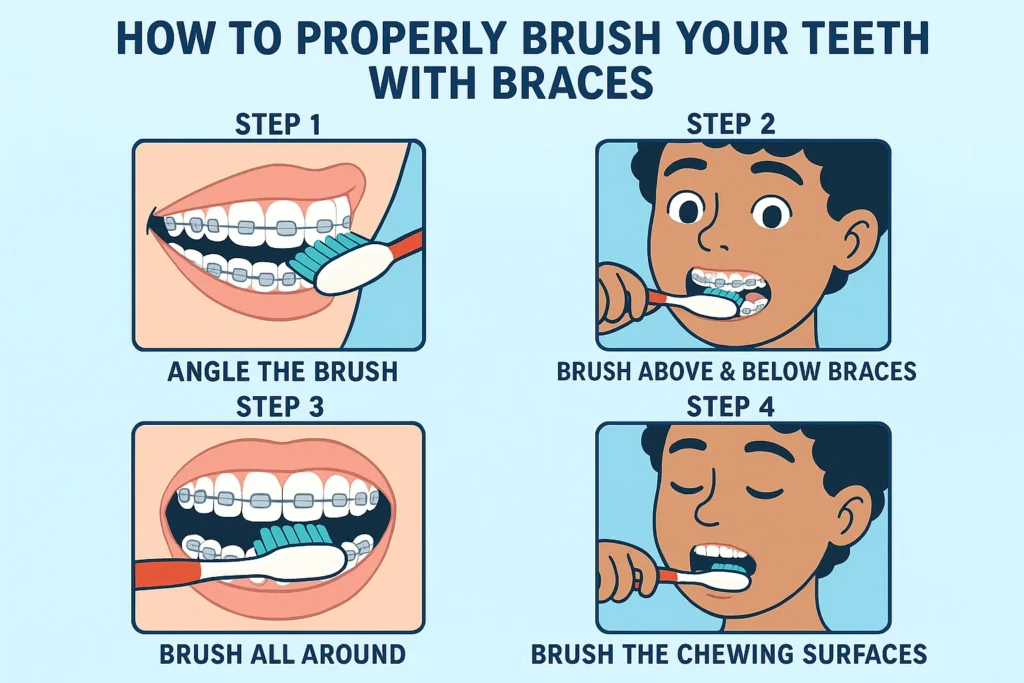
The process of brushing teeth with braces demands additional attention to detail and increased effort than standard oral hygiene practices. Thousands of patients with braces develop cavities due to improper brushing and flossing. The protection of your teeth from decay requires specific brushing methods which prevent plaque and bacteria from accumulating near your brackets and wires.
Brushing Technique
Set the angle of your toothbrush to 45-degrees to the gums as you brush backwards and scrub your teeth gently . Make sure to brush all surfaces including the intervals between the brackets and wires.
- Using a soft bristled toothbrush, will mitigate the damaging of your gums and braces.
- Using a 45-degree toothbrush angle to each bracket, clean the area using small circular motions to scrub gently.
- Targeted the area close to the gums, plaque is frequently found so scrubbing the area is extremely worthwhile.
- Ensure you clean the front and back of each chewing surface, and that you also clean the area around the brackets as all four surfaces should be attended to.
Tools to Use
Orthodontic toothbrush: These toothbrushes have V-shaped bristles that help clean around the brackets more effectively.
Interdental brush: A small brush designed to fit between the brackets and wires for deep cleaning.
Water flosser: A great tool for flushing out food particles from between the brackets.
Frequency of Brushing
Brush after every meal to prevent food particles from sticking to your braces.
Floss at least once a day to remove plaque between your teeth and around the brackets.
5. Common Toothpaste Mistakes to Avoid When You Have Braces
There are several common mistakes that people with braces often make when choosing or using toothpaste. Here’s what to avoid:
Effects of Using Whitening Toothpaste Too Early
The application of whitening toothpaste to orthodontic appliances leads to irregular whitening results. The best results will come after you remove your braces before using whitening pastes.
Effects of Using Abrasive Toothpaste
The use of abrasive toothpaste should be avoided in the same way as whitening toothpaste. The toothpaste you use during orthodontic treatment should not contain harsh abrasive materials that could damage your enamel.
Not Brushing Thoroughly
Compliance with the prescribed orthodontic treatment plan in conjunction with the oral hygiene regimen remains imperative. Effective brushing is critical, as inadequate brushing not only promotes plaque accumulation but may also lead to gingivitis and a host of other dental complications.
6. How to Maintain Oral Hygiene with Braces
In addition to choosing the right toothpaste for braces, you should maintain a comprehensive oral hygiene routine that includes:
Brushing: Brush your teeth after every meal and before bed.
Flossing: Use special flossing tools to clean between your teeth and around your brackets.
Mouthwash: Use a fluoride mouthwash to kill bacteria and protect your enamel.
Regular dental checkups: Visit your dentist and orthodontist regularly to monitor your progress and address any concerns.
7. Toothpaste Alternatives for Braces Care
If you’re looking for alternatives to toothpaste for better braces care, consider the following options:
Braces-Specific Mouthwash
Mouthwash products for individuals with braces should be targeted to their needs. The active substances present in these products help to plaque accumulation.
Interdental Brushes
Braces and wires are meticulously cleaned with interdental brushes, which are extremely useful for getting to the bracket-wire interface and other areas that are hard to reach.
Water Flossers
The application of pressurized water in a pulsating fashion to interdentally around the brackets is termed water flossing. Additional to the conventional brushing and flossing methods, water flossers serve as excellent adjunct tools.
8. Top Recommended Toothpastes for Braces
Some of the best toothpastes for braces include the following:
- Sensodyne Pronamel: Protective of enamel and integrating enhancement during orthodontic treatment, it is ideal for individuals with sensitive teeth.
- Colgate Total: Effective for users of braces, it offers comprehensive prevention of gum disease, cavities, plaque and protects against gingivitis.
- Oral-B Pro-Expert: This orthodontic treatment-friendly fluoride toothpaste wards off plaque and cavities.
- Tom’s of Maine Fluoride Toothpaste: Lacking harsh synthetic compounds, this braces-friendly gentle fluoride toothpaste is a natural option.
9. How to Prevent Tooth Decay and Staining with Braces
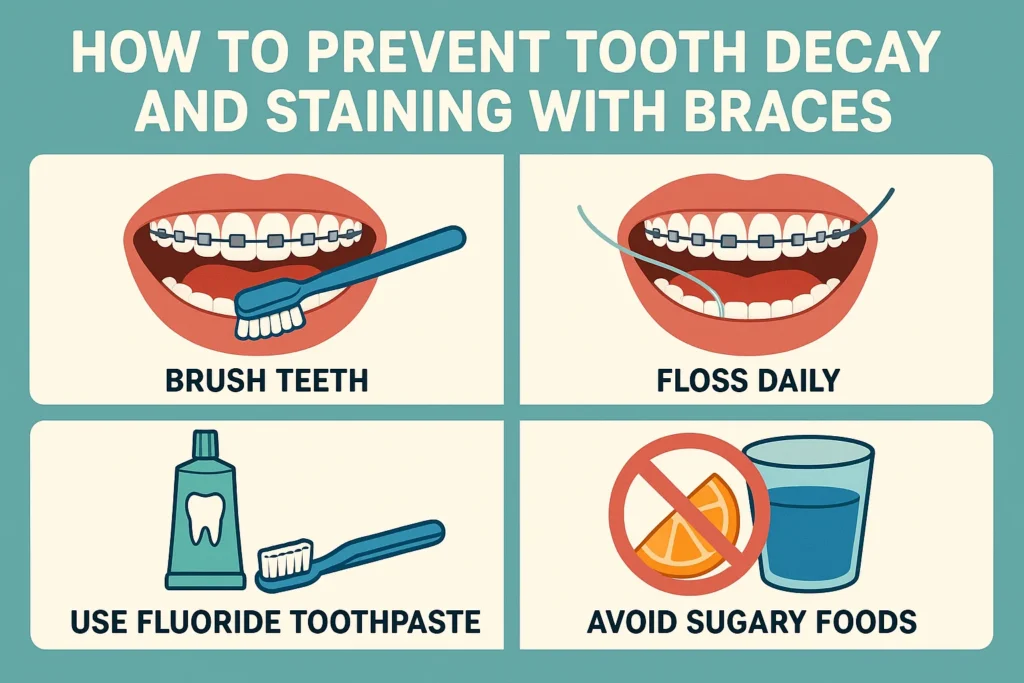
Tooth decay and staining are common concerns when you wear braces, but they are preventable. Here are some tips:
Brush and floss regularly to remove food particles and plaque.
Avoid sugary foods that can contribute to cavities.
Use fluoride toothpaste to strengthen your enamel.
Rinse with mouthwash to kill bacteria and keep your mouth fresh.
10. What to Do If You Notice Tooth Sensitivity with Braces
Tooth sensitivity is common when you first get braces or after an adjustment. If you experience sensitivity:
Use sensitive toothpaste, such as Sensodyne.
Avoid very hot or cold foods that might cause discomfort.
Consult your orthodontist if the sensitivity persists for a long period.
11. Can You Use Whitening Toothpaste with Braces?
While you have braces, it is best to avoid whitening toothpaste as it may result in uneven whitening. Whitening toothpaste works by employing agents that will be unable to reach all the necessary areas due to the brackets. After the braces have been taken off, feel free to use the toothpaste to further enhance your smile.
12. Final Thoughts on Choosing the Right Toothpaste for Braces
Choosing the right toothpaste also has an effect on having proper oral hygiene during the period of orthodontic treatment. Toothpastees with fluoride content which also has some antibacterial properties and has a mild abrasion action helps in controlling periopathogenic bacteria plaque and helps in having no cavities.
Good oral hygiene also demands using and brushing and flossing on a regular basis and attending scheduled appointments with the orthodontist. Effective control of periopathogenic plaque and appropriate orthodontic treatment will give a smile that is healthy and quite satisfying in terms of aesthetics.
What to Eat with Braces the First Week: Soft Foods for Your New Smile



